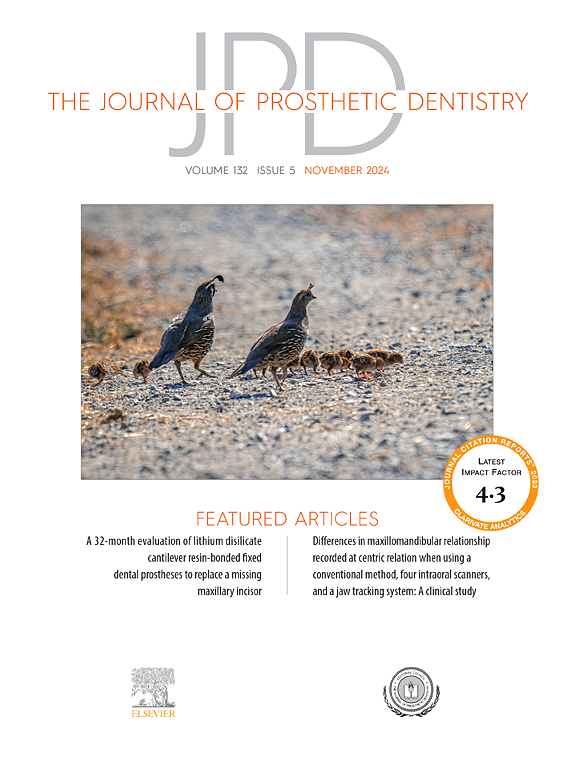使用四台口内扫描仪、一台台式扫描仪和一套摄影测量系统获得的全牙弓种植体扫描结果中,已连接和未连接的校准框架对准确性的影响。
IF 4.8
2区 医学
Q1 DENTISTRY, ORAL SURGERY & MEDICINE
引用次数: 0
摘要
目的:本体外研究的目的是比较使用口内扫描仪(IOS)、实验室扫描仪(LBS)和摄影测量(PG)记录的连接和不连接种植体扫描体(ISB)获得的完整牙弓扫描的准确性:材料和方法:获得一个包含 6 个种植体基台模拟体的铸模。创建了六组:TRIOS 4 组、i700 组、iTero 组、CS3800 组、LBS 组和 PG 组。IOS 和 LBS 组又分为 3 个亚组:非连接 ISB(ISB)、夹板 ISB(SSB)和校准框架(CF)(n=15)。在 ISB 亚组中,每个种植体基台模拟定位一个 ISB。对于 SSB 亚组,使用印刷框架连接 ISB。对于 CF 亚组,使用校准框架(IOSFix)连接 ISB。对于 PG 组,使用 PG(PIC 相机)进行扫描。使用坐标测量机测量了参考铸型的植入位置,并将欧氏距离作为参考,使用每次实验扫描获得的相同距离计算差异。使用 Wilcoxon 方差分析和成对多重比较来分析真实度(α=.05)。Levene 检验用于分析精确度(α=.05):结果:发现各组之间存在线性和角度差异(PC 结论:数字化方法和技术对精确度有影响:数字化方法和技术影响了种植体扫描的真实度和精确度。摄影测量组和校准框架组的精确度最高。除 TRIOS 4 外,校准框架法提高了通过使用测试的 IOS 获得的扫描的准确性。本文章由计算机程序翻译,如有差异,请以英文原文为准。
Influence of connected and nonconnected calibrated frameworks on the accuracy of complete arch implant scans obtained by using four intraoral scanners, a desktop scanner, and a photogrammetry system
Statement of problem
Different techniques have been proposed for increasing the accuracy of complete arch implant scans obtained by using intraoral scanners (IOSs), including a calibrated metal framework (IOSFix); however, its accuracy remains uncertain.
Purpose
The purpose of this in vitro study was to compare the accuracy of complete arch scans obtained with connecting and non-connecting the implant scan bodies (ISBs) recorded using intraoral scanners (IOSs), a laboratory scanner (LBS), and photogrammetry (PG).
Material and methods
A cast with 6 implant abutment analogs was obtained. Six groups were created: TRIOS 4, i700, iTero, CS3800, LBS, and PG groups. The IOSs and LBS groups were divided into 3 subgroups: nonconnected ISBs (ISB), splinted ISBs (SSB), and calibrated framework (CF), (n=15). For the ISB subgroups, an ISB was positioned on each implant abutment analog. For the SSB subgroups, a printed framework was used to connect the ISBs. For the CF subgroups, a calibrated framework (IOSFix) was used to connect the ISBs. For the PG group, scans were captured using a PG (PIC Camera). Implant positions of the reference cast were measured using a coordinate measurement machine, and Euclidean distances were used as a reference to calculate the discrepancies using the same distances obtained on each experimental scan. Wilcoxon squares 2-way ANOVA and pairwise multiple comparisons were used to analyze trueness (α=.05). The Levene test was used to analyze precision (α=.05).
Results
Linear and angular discrepancies were found among the groups (P<.001) and subgroups (P<.001). Linear (P=.008) and angular (P<.001) precision differences were found among the subgroups.
Conclusions
The digitizing method and technique impacted the trueness and precision of the implant scans. The photogrammetry and calibrated framework groups obtained the best accuracy. Except for TRIOS 4, the calibrated framework method improved the accuracy of the scans obtained by using the IOSs tested.
求助全文
通过发布文献求助,成功后即可免费获取论文全文。
去求助
来源期刊

Journal of Prosthetic Dentistry
医学-牙科与口腔外科
CiteScore
7.00
自引率
13.00%
发文量
599
审稿时长
69 days
期刊介绍:
The Journal of Prosthetic Dentistry is the leading professional journal devoted exclusively to prosthetic and restorative dentistry. The Journal is the official publication for 24 leading U.S. international prosthodontic organizations. The monthly publication features timely, original peer-reviewed articles on the newest techniques, dental materials, and research findings. The Journal serves prosthodontists and dentists in advanced practice, and features color photos that illustrate many step-by-step procedures. The Journal of Prosthetic Dentistry is included in Index Medicus and CINAHL.
 求助内容:
求助内容: 应助结果提醒方式:
应助结果提醒方式:


